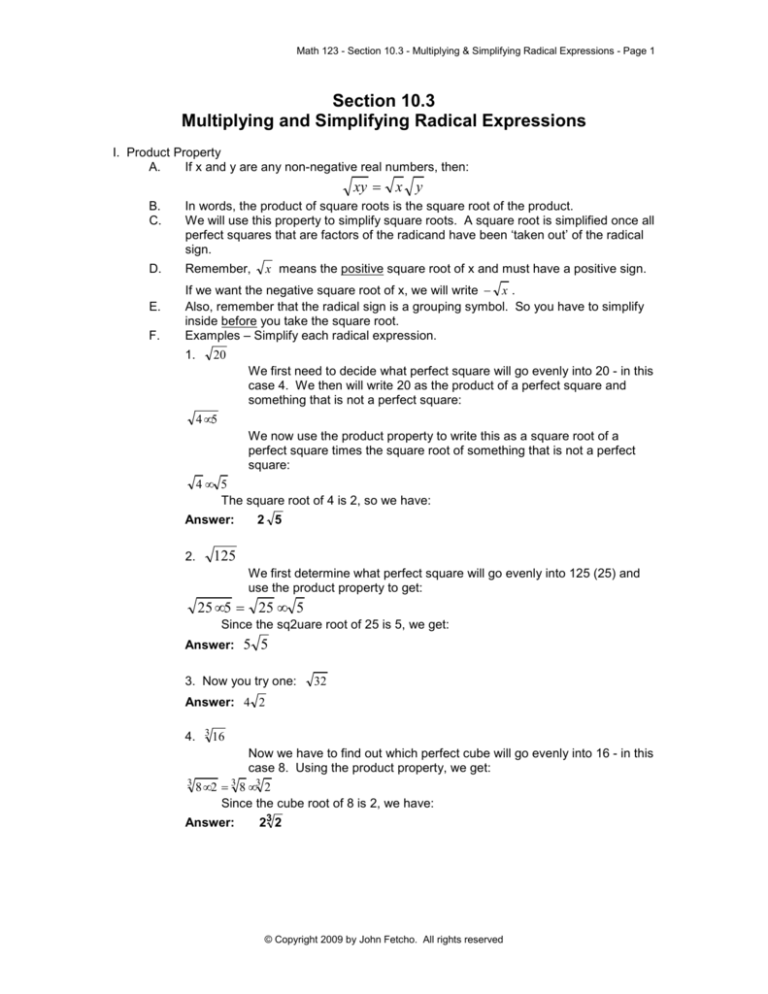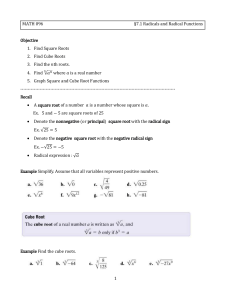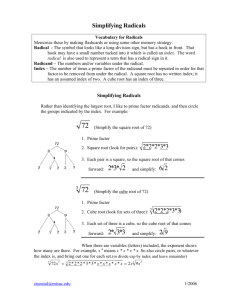
Math 123 - Section 10.3 - Multiplying & Simplifying Radical Expressions - Page 1
Section 10.3
Multiplying and Simplifying Radical Expressions
I. Product Property
A.
If x and y are any non-negative real numbers, then:
xy = x y
B.
C.
In words, the product of square roots is the square root of the product.
We will use this property to simplify square roots. A square root is simplified once all
perfect squares that are factors of the radicand have been ‘taken out’ of the radical
sign.
D.
Remember,
E.
If we want the negative square root of x, we will write − x .
Also, remember that the radical sign is a grouping symbol. So you have to simplify
inside before you take the square root.
Examples – Simplify each radical expression.
F.
1.
x means the positive square root of x and must have a positive sign.
20
We first need to decide what perfect square will go evenly into 20 - in this
case 4. We then will write 20 as the product of a perfect square and
something that is not a perfect square:
4•5
We now use the product property to write this as a square root of a
perfect square times the square root of something that is not a perfect
square:
4• 5
The square root of 4 is 2, so we have:
Answer:
2.
2 5
125
We first determine what perfect square will go evenly into 125 (25) and
use the product property to get:
25 • 5 = 25 • 5
Since the sq2uare root of 25 is 5, we get:
Answer:
5 5
3. Now you try one:
32
Answer: 4 2
4. 3 16
Now we have to find out which perfect cube will go evenly into 16 - in this
case 8. Using the product property, we get:
3
8• 2 = 3 8 •3 2
Since the cube root of 8 is 2, we have:
Answer:
23 2
© Copyright 2009 by John Fetcho. All rights reserved
Math 123 - Section 10.3 - Multiplying & Simplifying Radical Expressions - Page 2
− 56
Remember that we can take the cube root of a negative number - our answer
will just be negative. So we have to decide which perfect cube goes evenly
into 56, in this case 8:
3
5.
−8•7 = 3 −8 •3 7
And the cube root of -8 is -2. So we get:
3
Answer:
6.
− 23 7
Now you try one:
Answer:
3
− 54
−3 2
3
10 • 15
Using the product property to multiply the radicands, we get:
7.
150
Now we use the product property again, by deciding which perfect square
goes evenly into 150, in this case 25:
25 • 6 = 25 • 6
Answer:
5 6
8.
Now you try one:
Answer:
13
II.
13 • 13
Variables Under the Radical Sign
A. Procedure
1. Take the indicated root of the coefficient.
2. On the variable expression, divide the exponent by the index.
B. Examples – Simplify the following radical expressions.
1.
4
x 12
Since the coefficient is 1, we don’t need to worry about taking the fourth root
of the coefficient (it’s 1 by the way).
We do need to divide the exponent in the radical sign (12) by the index (4) to
12
take the fourth root of x .
3
Answer: x
2.
3
8a 30
First, we find the cube root of 8 (which is 2).
We then divide the exponent (30) by the index (3) to get the answer:
10
Answer: 2x
3. Now you try one:
81x 36 y 16
18 8
Answer: 9x y
4.
5
( x + y ) 20
Notice that even though it is a little bit more complicated than what we have
20
seen before, the radicand is (x + y) .
There is a coefficient of 1, and the fifth root of 1 is 1.
So now we divide the exponent (20) by the index (5) to get:
4
Answer: (x + y)
© Copyright 2009 by John Fetcho. All rights reserved








